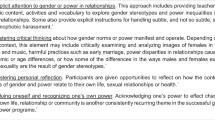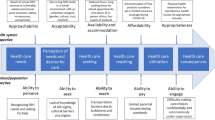Abstract
Young Latina women (YLW) in the US and in Alabama are disproportionately affected by sexual health disparities. Our community based participatory research (CBPR) study’s purpose was to examine YLW’s perceptions and experiences of sexual healthcare access (SHCA) toward developing community-driven, multilevel intervention strategies. We conducted 20 semi-structured qualitative interviews with YLW between 15 and 19 years old and who had been in the US for 5 or more years. We content-analyzed the data guided by the Socioecological Model of Sexual Health (SEMSH). We began analyses by coding independently, built consensus on the codes, then finished coding transcripts independently. Sixty-five percent of participants were US-born and 60% had health insurance. Participants identified barriers/facilitators to SHCA including discrimination in clinical settings and embarrassment/stigma about SHCA. Our study is the first in AL to use CBPR to work with YLW. Interventions should consider the multi-level and intersectional nature of SHCA challenges.
Similar content being viewed by others
References
Passel JS, Cohn D, Lopez MH. Hispanics account for more than half of nation’s growth in past decade. Pew Hispanic Center; 2011. https://www.pewresearch.org/hispanic/2011/03/24/hispanics-account-for-more-than-half-of-nations-growth-in-past-decade/. Accessed 16 Sept 2019.
Mohl RA. The politics of expulsion: a short history of Alabama’s anti-immigrant law, HB 56. J Am Ethn Hist. 2016;35(3):42–67.
White K, et al. Impact of Alabama’s immigration law on access to health care among Latina immigrants and children: implications for national reform. Am J Public Health. 2014;104(3):397–405.
Centers for Disease Control and Prevention. HIV surveillance report, 2016, vol. 28. Atlanta: Centers for Disease Control and Prevention; 2017.
Martin J, Hamilton B, Osterman M. National vital statistics report. 2017.
Kann L, et al. Youth risk behavior surveillance—United States, 2015. MMWR Surveill Summ. 2016;65(6):1–174.
Centers for Disease Control and Prevention. Screening recommendations and considerations referenced in treatment guidelines and original sources. 2015 STD treatment guidelines; 2015. https://www.cdc.gov/std/tg2015/screening-recommendations.htm. Accessed 15 May 2019.
Berglas NF, et al. Predisposing, enabling and need-for-care predictors of adolescents’ intention to use sexual health services. Sex Health. 2016;13(6):540–8.
Cashman R, et al. Exploring the sexual health priorities and needs of immigrant Latinas in the southeastern United States: a community-based participatory research approach. AIDS Educ Prev. 2011;23(3):236–48.
Felizzola J. Assessment of HIV/AIDS needs and pathways for change of Latinos in the southern United States: final report, in Latino Southern Reach. AIDS United Southern REACH; 2013.
Seal PS, et al. Sexual health knowledge of male and female Latino immigrants. J Immigr Minor Health. 2012;14(4):673–81.
Scarinci IC, et al. Sowing the seeds of health: training of community health advisors to promote breast and cervical cancer screening among Latina immigrants in Alabama. J Health Care Poor Underserved. 2016;27(4):1779–93.
Israel BA, et al. Critical issues in developing and following CBPR principles. In: Community-based participatory research for health: from process to outcomes, vol 2, San Francisco: Jossey-Bass; 2008. p. 47–66.
Tolman DL, Striepe MI, Harmon T. Gender matters: constructing a model of adolescent sexual health. J Sex Res. 2003;40(1):4–12.
Tolman DL, McClelland SI. Normative sexuality development in adolescence: a decade in review, 2000–2009. J Res Adolesc. 2011;21(1):242–55.
Raffaelli M, Kang H, Guarini T. Exploring the immigrant paradox in adolescent sexuality: an ecological perspective. In: Garcia C, Marks AK, editors. The immigrant paradox in children and adolescents: Is becoming American a developmental risk?. Washington, DC: American Psychological Association; 2012. p. 109–34.
Ferreti G. Let’s empty the clip: state-level immigration restriction and community resistance. In: Anthropology. University of Texas at Austin: Austin; 2016.
Gale NK, et al. Using the framework method for the analysis of qualitative data in multi-disciplinary health research. BMC Med Res Methodol. 2013;13(1):117.
O’Reilly M, Parker N. ‘Unsatisfactory Saturation’: a critical exploration of the notion of saturated sample sizes in qualitative research. Qual Res. 2013;13(2):190–7.
Davila YR. The social construction and conceptualization of sexual health among Mexican American women. Res Theory Nurs Pract. 2005;19(4):357.
Population Institute. 50 State report card on reproductive health and rights. 2018.
Alabama Code Title 16. Education § 16-40A-2.
Ferreti G, Morales-Aleman MM. No Te Tratan Bien Porque Eres Mexicana: intersectional systemic violence and precarity in Latina adolescent life in the U.S. South. Peace Confl J Peace Psychol. 2018 (in press).
Raymond-Flesch M, et al. “There is no help out there and if there is, it’s really hard to find”: a qualitative study of the health concerns and health care access of Latino “DREAMers”. J Adolesc Health. 2014;55(3):323–8.
Singer A, Svajlenka NP. Immigration facts: Deferred Action for Childhood Arrivals (DACA). Washington, DC: The Brookings Institution; 2013.
Castañeda H, Melo MA. Health care access for Latino mixed-status families: barriers, strategies, and implications for reform. Am Behav Sci. 2014;58(14):1891–909.
Vargas ED. Immigration enforcement and mixed-status families: the effects of risk of deportation on Medicaid use. Child Youth Serv Rev. 2015;57:83–9.
Shommu NS, et al. What is the scope of improving immigrant and ethnic minority healthcare using community navigators: a systematic scoping review. Int J Equity Health. 2016;15(1):6.
Venkataramani AS, et al. Health consequences of the US Deferred Action for Childhood Arrivals (DACA) immigration programme: a quasi-experimental study. Lancet Public Health. 2017;2(4):e175–81.
Decker M, Berglas N, Brindis C. A call to action: developing and strengthening new strategies to promote adolescent sexual health. Societies. 2015;5(4):686.
Minguez M, et al. Reproductive health impact of a school health center. J Adolesc Health. 2015;56(3):338–44.
O’Uhuru DJ, et al. Bronx teens connection’s clinic linkage model: connecting youth to quality sexual and reproductive health care. J Adolesc Health. 2017;60(3):S38–44.
Dittus PJ, et al. Structural intervention with school nurses increases receipt of sexual health care among male high school students. J Adolesc Health. 2018;62(1):52–8.
White K, Scarinci IC. Comparison of self-rated health among Latina immigrants in a Southern U.S. city and a national sample. Am J Med Sci. 2015;350(4):290–5.
Molinsky A. Cross-cultural code-switching: the psychological challenges of adapting behavior in foreign cultural interactions. Acad Manag Rev. 2007;32(2):622–40.
Goodyear-Smith F, Buetow S. Power issues in the doctor–patient relationship. Health Care Anal. 2001;9(4):449–62.
Halman M, Baker L, Ng S. Using critical consciousness to inform health professions education. Perspect Med Educ. 2017;6(1):12–20.
Hardeman RR, Medina EM, Kozhimannil KB. Structural racism and supporting Black lives—the role of health professionals. N Engl J Med. 2016;375(22):2113–5.
Anderson PM, Vanderbilt AA. Bridging the gap between physician and medical student education: using the Train the Trainer model to improve cultural competence training in the clerkship years of medical school. Adv Med Educ Pract. 2018;9:495.
Neff J, et al. Teaching structure: a qualitative evaluation of a structural competency training for resident physicians. J Gen Intern Med. 2017;32(4):430–3.
Centers for Disease Control and Prevention. Familias Unidas: best evidence—risk reduction. Compendium of Evidence-Based Interventions and Best Practices for HIV Prevention. 2015 (August 22, 2018).
U.S. Department of Health and Human Services. Evidence-based TPP programs. 2015 (September 20, 2018).
Guilamo-Ramos V, et al. A parent-based intervention to reduce sexual risk behavior in early adolescence: building alliances between physicians, social workers, and parents. J Adolesc Health. 2011;48(2):159–63.
Acknowledgements
We would like to thank our study participants and the members of our Community Advisory Board for generously lending their time and insights to this study.
Funding
Research reported in this manuscript was supported by the National Center for Advancing Translational Sciences of the National Institutes of Health under Award Number UL1TR001417.
Author information
Authors and Affiliations
Corresponding author
Ethics declarations
Conflicts of interest
Authors have no conflicts of interest to disclose.
Additional information
Publisher's Note
Springer Nature remains neutral with regard to jurisdictional claims in published maps and institutional affiliations.
Rights and permissions
About this article
Cite this article
Morales-Alemán, M.M., Ferreti, G. & Scarinci, I.C. “I Don’t Like Being Stereotyped, I Decided I Was Never Going Back to the Doctor”: Sexual Healthcare Access Among Young Latina Women in Alabama. J Immigrant Minority Health 22, 645–652 (2020). https://doi.org/10.1007/s10903-019-00932-3
Published:
Issue Date:
DOI: https://doi.org/10.1007/s10903-019-00932-3




